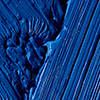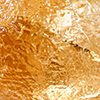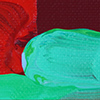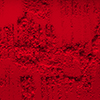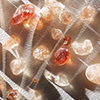I have spent my whole life within the world of colour. Looking back, it could be mistaken for destiny but how I got to this place in time is a tale of serendipity, family legacy, chance meetings, wrong turns and a tenacious pursuit of the alchemical transformation of dirt into colour.
My father was an advertising illustrator; the house was always full of paints, paper, markers and pencils. During school holidays, my brother and I would take the train with him up to his London studio, part of a ramshackle early-Victorian five-storey building split up into a labyrinth of studios for artists, writers, calligraphers and agents. That building is no longer standing; it is one of many that were pulled down during the redevelopment of Covent Garden. During one of these visits, a most significant event occurred. I was taken to Cornelissen & Son, the famous art materials store, then still in Great Queen Street where it had stood since 1863. Walking in, I was overwhelmed by the smell of oil-primed canvas that had accreted to the interior of the store over decades, and the unctuous aroma of painting oils and balsams. Arrayed in a giant cabinet of solid black timber were giant glass jars of pure pigments, natural resins, gums and waxes. Each jar had a label, describing its contents – gamboge, Japan wax, sandarac, terre-verte, copaiba balsam, gum elemi – tempting me into a world of stories of their exotic origins.
Back in my country town, I began working in the family art store. I had already started to paint and the knowledge I learnt in the shop began to inform my art practice. Around this time, I was given a set of pigments, and those tiny jars – sparkling, like powdered jewels – set me on my path to an obsession with colour. With support from my parents, I applied myself to becoming an artist, and at eighteen started my studies in painting at Bristol Art College under a traditional system of studying composition and colour.
An integral part of our training was the preparation and manufacture of the artist’s materials: canvas, paint, mediums and varnishes. This was the early 1980s, painting was back in favour, and students around me were rediscovering the paints and materials abandoned by previous generations. Some experimented with the ancient technique of encaustic, painting with pigmented molten wax. Others tried their hand at distemper, hand-making their paint from warm solutions of rabbit-skin glue, chalk and pigment. All this experimentation, and the encouragement of our lecturers, left us with the realisation that we were part of a ‘golden chain’ of history that could be traced back all the way through the centuries to the Renaissance and beyond.
After college I moved to London and ended up getting a job, over a decade after my first visit, at Cornelissen’s. Here I truly began my apprenticeship in the history of colour. As one of the most venerable art materials stores in the world, it had incredibly high standards for knowledge of the materials we sold and how they should be mastered. Working with like-minded staff heightened my immense curiosity about the materials of artists and traditional craftsmen. Many of the specialist tradespeople who frequented the store used techniques going back centuries. Through them, I entered a world of craft lore, where it was understood that the physical could hold metaphysical and magical qualities.
After work, evenings at home were spent making concoctions from 18th-century recipes – cooking, dissolving, filtrating and synthesising raw materials and pigments to hand-make paints, mediums and grounds. It was eternally fascinating. That was the point when I realised my future was to work with colour, from its raw ingredients through to beautifully crafted paint.
Founding Langridge Artist Colours
In 1992 I emigrated to Australia, determined to build a business on my knowledge and passion for colour. Langridge Artist Colours initially supplied the materials I knew best – artist-quality pigments and my own range of oil mediums – to artists and friends within the Melbourne art world.
For the first twelve years, the original factory was in Langridge Street (from which the company derives its name), in Collingwood. At this time, I didn’t have enough money to buy the equipment to manufacture oil paints, so every bit of profit was set aside to go towards the purchase of a paint-making mill.
In 1999 I inherited a small double-roll mill, the most basic of paint-making machines. Four years later, having saved enough, I was able to afford a small triple-roll mill and begin paint- making in earnest. There are, unsurprisingly, no vocational courses on artist paint-making and I was too young and ambitious to want an apprenticeship with one of the handful of paint-makers in the world. Instead, I threw myself into what ended up being years of trial and error and self-education – thousands of hours hunched over a triple-roll mill attempting to make an oil paint worthy of my ambition. Our dioxazine violet – a modern, crazily intense deep cool purple – took ten laborious hours to mill. The end result, however, was paint so full of pigment that the purple looked almost black as it was squeezed from the tube. Things became a lot easier when we purchased a large, fifty- year-old Lehmann-made granite triple roll mill.
A new home
In 2004 Langridge moved to a larger factory in Yarraville in Melbourne’s inner west where I continued to refine the oil paint formulations. The following year, we finally released our oil paint to the world.
In recent years, we have created our own unique colours at Langridge. Many of our colours are attempts to replicate Australian light, which is vastly different to that of Europe or America. The searing sunlight here excites all colours it touches, creating a high chromatic vibration that is immediate and modern.
After almost forty years working with colour I’m still amazed at its power to excite emotions. Whether it is the discovery of a pigment’s history (some are as old as the ages), or the electrifying sensation of seeing a new modern pigment for the first time, this excitement has never left me.
